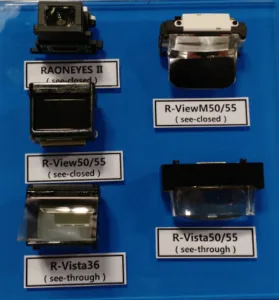We did not review the many papers on AR/VR at SID, so below is a summary of what was being shown on the exhibit floor.
BOE showed a prototype panel that was 2.8” in diagonal and had UHD resolution. That works out as 1600 ppi – squarely in microdisplay territory, yet it is a direct view device. It is aimed directly at AR/VR applications.
It is fabricated using an LTPS backplane and achieves 100% of the NTSC color gamut or 92% of the BT 2020 color gamut. We asked if they got this high color gamut using quantum dots and the answer was a surprising “No”. But they did not reveal how they did it.
Brightness was specified at 200 cd/m², but the demo on display was far less bright – probably only 40-50 cd/m². No more info on the prototype was available.

QD Laser, Inc. was in the Innovation Zone showing off its AR headset. This is a monocular device that features a scanning laser that delivers images directly to your retina. The company says this means the image distance is not adjustable, but it appears to be floating perhaps a foot from your eye. To be able to change the apparent distance would require a binocular design so you could adjust the parallax, they said.
The image is a bit hard to acquire but was visible on the exhibit floor. The size and content was such that it was impossible to really judge the image quality or visibility of speckle. Resolution is 1280×720.
QD Laser is a laser company offering low power lasers for many applications. In this case, they decided to integrate micro-watt level RGB lasers with a MEMS scanning mirror. The device is being targeted at people with low levels of vision, but this will require FDA approval. It is a low power laser system so it is considered class 1 and eye safe. It will also be expensive – $5-7K. First targets for the device are the US, Japan and Europe.
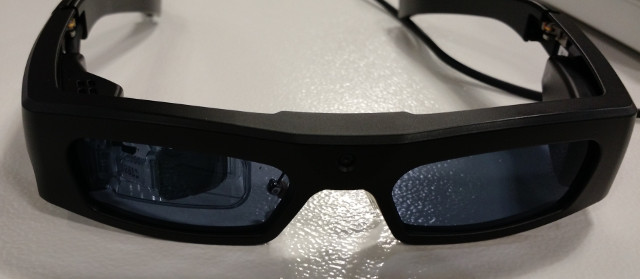 Raontech Co. is a Korean IC design house that was focusing on LCOS devices and solutions at SID. They were in the Innovation Zone showing their LCOS panels and some prototype VR/AR headsets – mainly to showcase the applications, not to sell headsets.
Raontech Co. is a Korean IC design house that was focusing on LCOS devices and solutions at SID. They were in the Innovation Zone showing their LCOS panels and some prototype VR/AR headsets – mainly to showcase the applications, not to sell headsets.
The company makes a number of IC components including mobile TV RF chips, Mobile TV SOCs and wireless connectivity chips. But they also design LCOS backplanes, working with other foundries to get the LCOS panels fabricated for customers. Current designs include a 0.55” 1080 panel and a 0.37” 720p panels. They also design the image controller chip.
On display were some of the optical viewfinder modules they have developed for AR/VR and viewfinder applications as well as a binocular glasses type headset.
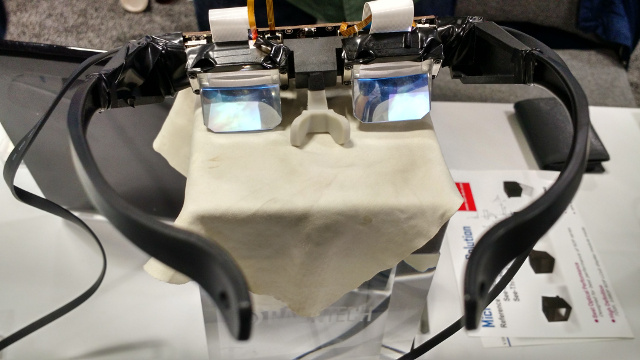
Teracle was also in the Innovation Zone showing off an eyeglass-type HMD. They have just completed a Kickstarter campaign raising $42,760 to manufacturer their device, called Teraglass, which they characterize as a ‘fully customizable HMD’.
The headset is a binocular type that uses two 2550 ppi OLED displays from Sony. Image quality was excellent and the stereo images not too bad at all. The price of the retail product is expected to be about $399.
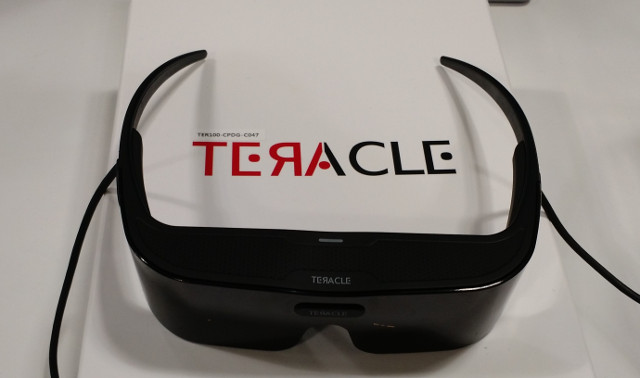
Applications profiled on the Kickstrater site included mostly VR immersive applications that were basically mirroring what was playing on a portable device. That might be useful for playing a game or watching a video, for example. The HMD can also be used to drive a drone, again mirroring what is being shown on a mobile device anyway. Connection to the mobile device is by an HDMI cable.
We also had a chance to talk to eMagin at the show. While they were not announcing anything new, they noted that their main focus is on development of the new 2Kx2K panel, which should be ready by the end of the year. This is aimed squarely at VR applications.
We also learned that the chip will offer a lot of new controllability features, meaning there is a lot of flexibility in how the display can be addressed. For example, there has been a lot of talk about foveated imaging lately which takes advantage of the eye’s higher resolution in the center vs. lower resolution outside of this region. The new 2Kx2K panel will support this application by offering two zones of addressability. One would be a central zone with native resolution surrounded by a an area that can be addressed with lower resolution. The native resolution does not change in this area, but the addressability can be lowered creating additional bandwidth that can be used to reduce latency, for example.
The 2Kx2K chip also implements a global shutter as opposed to a rolling shutter method for updating the display. This is important for HMD applications when the head moves quickly.
eMagin’s Senior VP of R&D, Dr. Amal Ghosh, also presented a paper entitled, “Directly Patterned 2645 PPI Full Color OLED Microdisplay for Head Mounted Wearables.” Immediately following the presentation of the paper, eMagin demonstrated for the first time in public a direct patterned OLED microdisplay that can reach a maximum luminance of 4500 cd/m² with vivid colors and in full video mode.
The new display, designated OLED-ULT, provides brightness that meets or exceeds the requirements for the augmented reality (AR) and virtual reality (VR) markets. The company said it is working to achieve 10,000 cd/m² by mid 2017.
Andrew G. Sculley, President and CEO of eMagin noted that, “This demonstration generated tremendous interest from hundreds of attendees including a number representing Tier 1 display companies. We are currently shipping our OLED-ULT displays as engineering samples to a few key customers that are interested in ultra-high brightness microdisplays for applications as diverse as aviation head mounted displays to AR and VR applications. Our current expectation is that we will begin shipping additional engineering samples to other customers in the fourth quarter of 2016.”
The highlight of the Digilens booth was their motorcycle HUD that is being developed for BMW. We reported on this before and it was shown at CES as well, but the exhibit at SID allowed people to put on the HUD/helmet, get on a BMW motorcycle and watch a video of a motorcycle ride with information displayed in the HUD – thus simulating the real experience. This actually received an SID award as well. BMW has now confirmed the production of the HUD for commercial availability in early 2017.
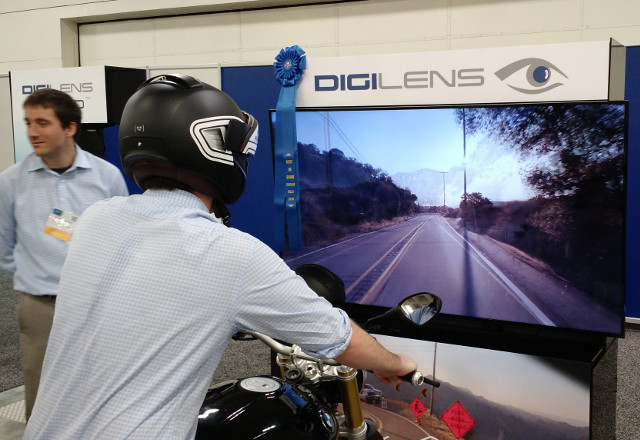
Digilens has pioneered their switchable Bragg grating technology that allows the creation of waveguide-based augmented reality images with the widest field of view (40 degrees today and moving to 50 degrees soon). The key is their very high index photopolymer for defining the holograms. Competitive approaches, like the surface relief holograms used by the Microsoft Hololens, for example, are limited in the field of view to 25-30 degrees.
The company also showed their avionic HUD in production for Rockwell Collins. Digilens is now in the process of transferring this production from their Bay-area headquarters to Rockwell Collins’ Portland Oregon facility.
And that’s the AR/VR/HUD news from the SID DisplayWeek 2016 trade show floor. -CC

